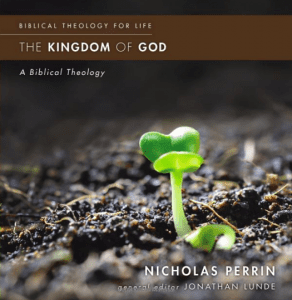 Where do we begin to comprehend “kingdom”? Nick Perrin begins with God in his new book The Kingdom of God: A Biblical Theology.
Where do we begin to comprehend “kingdom”? Nick Perrin begins with God in his new book The Kingdom of God: A Biblical Theology.
A classic form of kingdom theology begins with creation, and this is where Perrin kicks off his discussion, and he highlights two important themes:
Creation, Scripture tells us, is God’s handiwork, God’s art. This means that we are all essentially living in a museum filled with God’s artwork. When we open our eyes every morning, we are confronted with the glory of God revealed in creation (Ps. 19; Rom. 1:19-20). The canvas reflects the artist. We can take our tour of creation on our own, but it is recommended that we get some help from the ‘rented headset” of special revelation, the Scriptures, whence we can hear from the artist himself. Scripture’s first and most basic account of creation is found in Genesis 1. There’s a lot to say—and a lot that has been said—about this passage. But what do we learn about God’s creation that’s related to the ‘what” of the kingdom? Two points: creation is a sovereign act and a paradigmatic act.
Creation, he is arguing, is God’s decision for God’s own reasons, and Perrin contends he does so as king. OK, but that is not the term used for God in Genesis 1-2 though one might infer something along this line from “image of God”. God is not only sovereign, God’s creation is paradigmatic. He puts it like this: “And if Yahweh’s creation was to provide a kind of audiovisual reminder of righteous behavior for the appointed royal mediator, it was the royal mediator’s job to image that righteousness for the people” — thus, as with God, so with God’s earthly kings. Perrin:
So, then, although the image of Yahweh was assumed to reside in Israel’s priest-king in a special sense, there is another sense in which God created humanity as a whole with a view to (1) establishing a father-son/daughter relationship with humanity; (2) extending a real divine presence through a proxy, tasked with ruling and subduing creation; and (3) carving out sacred space physically centered around the image-bearer. Our identity as image-bearers has major entailments of kinship (our relationships), kingship (our authority), and cultus (our vocation of worship).
He continues with his paradigm of God as king as creation with the following main points:
In determining the meaning of the “kingdom of God,” it is important to do justice to the full array of biblical data by taking into account the witness of the biblical canon. When we do so, we discover that the idea of kingdom is consistently worked out in a framework that assumes (1) a morally obliging relationship between Yahweh and the nations; (2) the election of Israel as the mediator of that relationship; and (3) a linear notion of history, that is, a vision of the world’s story that has a beginning, a middle, and an end.
Perrin is one of the few who see kingdom in terms of space and people, so he connects God’s rule to God’s temple and God’s Land, the location of God’s temple.
The earthly temple was meant as a living, functioning image of the true cosmic temple. Yahweh dwelled in both places, with the earthly temple regarded as a kind of analogue to and extension of Yahweh’s heavenly courtroom. To enter the temple area was to come into the threshold of the divine presence, the escalator between heaven and earth.
All leading to his opening (italicized) definition:
Creationally engaged, universally focused, and eschatologically oriented, the kingdom of God is a transcendent sphere of reality that conspires with a community of human image-bearers in the task of restoring creation to the worship of the one true creator God.











